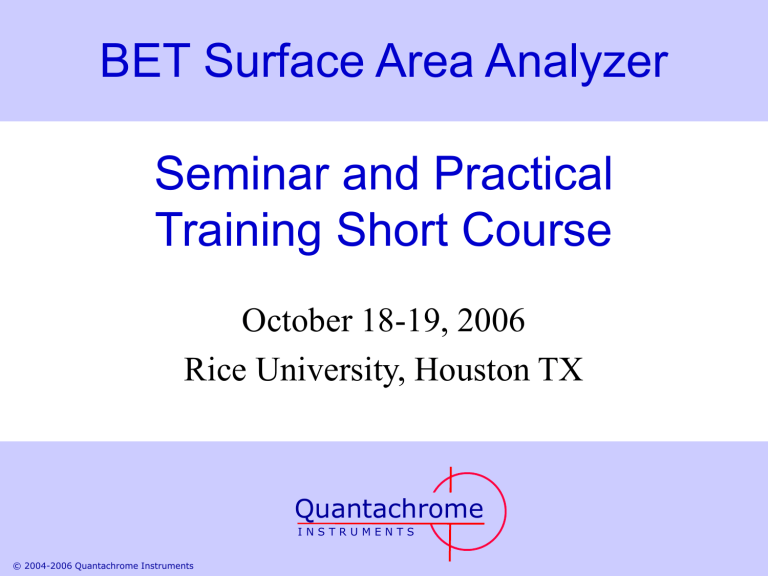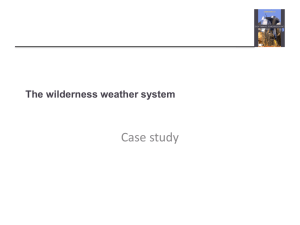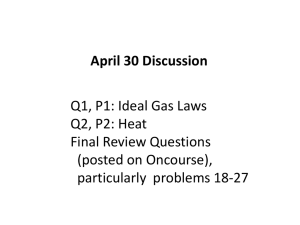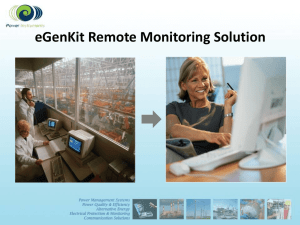Properties - Rice University

BET Surface Area Analyzer
Seminar and Practical
Training Short Course
October 18-19, 2006
Rice University, Houston TX
Quantachrome
I N S T R U M E N T S
Quantachrome
Quantachrome Instruments Corporate Headquarters,
Boynton Beach, Florida
•
Quantachrome...renowned innovator of ideas for today's particle technology needs. For more than 30 years,
Quantachrome's scientists have revolutionized measurement techniques and designed instrumentation to enable the accurate, precise, and reliable characterization of powdered and porous materials.
•
Products designed and manufactured to
ISO9000.
© 2004-2006 Quantachrome Instruments
Martin Thomas PhD
•
PhD; Birmingham University, U.K.
•
Research Investigator, Cookson Group
•
Principal Research Officer, ICI Katalco
•
With Quantachrome since 1991
•
ASTM Committee Member (D32, D24, D11, C01)
•
Co-Author “Characterization of Porous Solids and
Powders: Surface Area, Pore Size and Density” by S. Lowell, J.E Shields, M.A. Thomas & M. Thommes pub.Springer (2004)
© 2004-2006 Quantachrome Instruments
Autosorb-3B
Measure surface area and pore size of up to 3 samples simultaneously .
Autosorb-3B equipped with three built-in degas ports.
Features BatchStart and
MaxiDose operating methods.
Autosorb ® -3B
© 2004-2006 Quantachrome Instruments
Quantachrome
I N S T R U M E N T S
Surface Area
& Gas Sorption
Surface Area – What is it?
“Surface Area is the means through which a solid interacts with its surroundings, especially liquids and gases.”
Surface area is created by division of particles (size reduction) and the generation of porosity.
Surface area is destroyed by sintering
(exceeding T g
), melting and Ostwald ripening.
© 2004-2006 Quantachrome Instruments
© 2004-2006 Quantachrome Instruments
How to Create Area
•
Size Reduction
– Grinding,
– milling,
– nanoscale preparation
•
Make pores
– Partial decomposition
– Leach
– Gel then lyophilize
How to Destroy Area
•
Surface area is destroyed by
– melting
– sintering (exceeding T g
), and
– Ostwald ripening
© 2004-2006 Quantachrome Instruments
Surface Area – Importance?
Remember that surface area is the means through which a solid interacts with its surroundings.
Consider the following four interactions:
Solid-Solid: adhesion
Solid-Solid: autohesiveness (cohesiveness) eg flow, compactibility etc.
Solid-Liquid: wetting, non-wetting, adsorption capacity etc.
Solid-Gas: adsorption, catalysis, etc.
© 2004-2006 Quantachrome Instruments
Adhesion
Carbon black is used as a reinforcing agent in rubber.
Different grades of carbon black are used in tire innerliners, carcasses, sidewalls and treads, as well as in industrial rubber products, like belts, hoses and gaskets .
Race compound is formulated with specialized ultra-fine carbon black to yield higher grip.
© 2004-2006 Quantachrome Instruments
© 2004-2006 Quantachrome Instruments
Autohesion
Liquid-Solid Interaction
Wicking: adhesive forces exceed cohesive forces… liquid wax is drawn up through fibers of wick to the exterior where it evaporates, mixes with air and burns upon ignition from the hot gases above.
© 2004-2006 Quantachrome Instruments
Gas-Solid Interaction
© 2004-2006 Quantachrome Instruments
The gas sorption process
•
Langmuir
[1] described the kinetic behavior of the adsorption process. He postulated that at equilibrium, the rate of arrival of adsorptive
(adsorption) and the rate of evaporation of adsorbate (desorption) were equal.
•
Furthermore, the heat of adsorption was taken to be constant and unchanging with the degree of coverage, θ.
[1] I. Langmuir, J. Amer. Chem. Soc ., 40 , 1368 (1918)
© 2004-2006 Quantachrome Instruments
Irving Langmuir (1881-1957) http://public.lanl.gov/alp/plasma/history.html
Graduated as a metallurgical engineer from the
School of Mines at Columbia University in 1903
1903-1906 M.A. and Ph.D. in 1906 from
Göttingen.
1906-1909 Instructor in Chemistry at Stevens
Institute of Technology, Hoboken, New Jersey.
1909 –1950 General Electric Company at
Schenectady where he eventually became
Associate Director
1913 :Invented the gas filled, coiled tungsten filament incandescent lamp.
1919 to 1921, his interest turned to an examination of atomic theory, and he published his "concentric theory of atomic structure" . In it he proposed that all atoms try to complete an outer electron shell of eight electrons
© 2004-2006 Quantachrome Instruments
http://public.lanl.gov/alp/plasma/history.html
Irving Langmuir (1881-1957)… continued
1927 Coined the use of the term " plasma " for an ionized gas.
1935-1937 With Katherine Blodgett studied thin films.
1948-1953 With Vincent Schaefer discovered that the introduction of dry ice and iodide into a sufficiently moist cloud of low temperature could induce precipitation.
1932 The Nobel Prize in Chemistry "for his discoveries and investigations in surface chemistry"
© 2004-2006 Quantachrome Instruments
Langmuirian behavior
Confining adsorption to a monolayer , the Langmuir equation can be written
V
V m
KP
1 KP where V is the volume of gas adsorbed at pressure P ,
V m is the monolayer capacity (i.e. θ=1) expressed as the volume of gas at STP and K is a constant for any given gas-solid pair. Rearranging in the form of a straight line (y=ab+x) gives
P
V
1
KV m
P
V m
© 2004-2006 Quantachrome Instruments
Quantachrome
I N S T R U M E N T S
Gas Sorption
Isotherms
Suitable Methods of
Determination
• Gas adsorption allows probing of entire surface including irregularities and pore interiors.
• The amount adsorbed is a function of temperature, pressure and the strength of attraction or interaction potential.
• Physisorption is generally weak and reversible. The solid must be cooled and a method used to estimate the monolayer coverage from which surface area can be calculated.
© 2004-2006 Quantachrome Instruments
The gas sorption process intermolecular forces
4E-07
2E-07
0
8 10 12 14 16 18 20 22 24
-2E-07
-4E-07 Lennard-Jones potential function
© 2004-2006 Quantachrome Instruments
Series 1
Adsorption Process
Adsorbate
Adsorptive
Adsorbent
© 2004-2006 Quantachrome Instruments
The Isotherm
•
The amount of gas adsorbed is a function of
– The strength of interaction between gas and solid (intrinsic)
– Temperature (fixed)
– Pressure (controlled variable)… expressed as relative pressure P/Po
© 2004-2006 Quantachrome Instruments
Saturation Pressure
Po, p
0
, p
sat
Po value can be
• measured in a dedicated cell
– with or
– without dedicated transducer
• calculated from atmospheric pressure
• input manually (eg Kr 2.63mmHg at 77.4K)
• measured in cell over sample
© 2004-2006 Quantachrome Instruments
© 2004-2006 Quantachrome Instruments
2
Physisorption Process
4)
Very Low Pressure Behavior
(micropore filling)
© 2004-2006 Quantachrome Instruments
Relative Pressure, P/Po
Low Pressure Behavior
(monolayer)
The “knee”
© 2004-2006 Quantachrome Instruments
Relative Pressure, P/Po
Medium Pressure Behavior
(multilayer)
© 2004-2006 Quantachrome Instruments
Relative Pressure, P/Po
High Pressure Behavior
(capillary condensation)
© 2004-2006 Quantachrome Instruments
Relative Pressure, P/Po
Types of Isotherms
Limiting value (plateau) due to filled pores and essentially zero external area.
Type I or pseudo“Langmuir”
Steep initial region due to very strong adsorption, for example in micropores.
© 2004-2006 Quantachrome Instruments
Relative Pressure (P/Po)
Types of Isotherms
Absence of hysteresis indicates adsorption on and desorption from a non-porous surface..
Type II
Low slope region in middle of isotherm indicates first few multilayers
Rounded knee indicates approximate location of monolayer formation.
Relative Pressure (P/Po)
© 2004-2006 Quantachrome Instruments
Types of Isotherms
Example: krypton on polymethylmethacrylate
Type III
Lack of knee represents extremely weak adsorbate-adsorbent interaction
BET is not applicable
Relative Pressure (P/Po)
© 2004-2006 Quantachrome Instruments
Type IV
Types of Isotherms
Hysteresis indicates capillary condensation in meso and macropores.
Closure at P/Po~0.4 indicates presence of small mesopores
(hysteresis would stay open longer but for the tensilestrength-failure of the nitrogen meniscus.
Rounded knee indicates approximate location of monolayer formation.
Low slope region in middle of isotherm indicates first few multilayers
Relative Pressure (P/Po)
© 2004-2006 Quantachrome Instruments
Types of Isotherms
Example: water on carbon black
Type V
Lack of knee represents extremely weak adsorbate-adsorbent interaction
BET is not applicable
Relative Pressure (P/Po)
© 2004-2006 Quantachrome Instruments
Choice of Gas and
Temperature
•
Gases
– Nitrogen
– Argon
– Krypton
– Carbon dioxide
– Others
•
Temperatures
– Liquid Nitrogen
– Liquid Argon
– Dry ice/acetone
– Water/ice
– Others
© 2004-2006 Quantachrome Instruments
Choice of Gas and
Temperature
•
Gases
– Nitrogen
– Argon
– Krypton
– Carbon dioxide
– Others
•
Temperatures
– Liquid Nitrogen
– Liquid Argon
– Dry ice/acetone
– Water/ice
– Others
© 2004-2006 Quantachrome Instruments
Quantachrome
I N S T R U M E N T S
Apparatus &
Measurement
Measurement Method
Manometric
(Classical vacuum, volumetric.)
Requires that adsorbate be adsorbed by the sample, at some reduced temperature, as a function of pressure of pure adsorptive.
© 2004-2006 Quantachrome Instruments
Manometric
•
P/Po values are achieved by creating conditions of partial vacuum.
•
High precision and accurate pressure transducers monitor pressure changes due to the adsorption process.
© 2004-2006 Quantachrome Instruments
© 2004-2006 Quantachrome Instruments
Manometric
Working Equation
PV = nRT n ads
= n dosed
- n void n ads
= (
PV/RT) man.
- (PV/RT) cell
© 2004-2006 Quantachrome Instruments
Working Equation
n ads
= (
PV/RT) man.
- (PV/RT) cell
That is, the amount adsorbed is calculated as the difference between a) the amount of gas “dosed” from the manifold to the cell and b) the mount of gas which remains not adsorbed at the end of the “equilibration time”.
© 2004-2006 Quantachrome Instruments
Quantachrome
I N S T R U M E N T S
BET Calculation
Principles of BET Surface Area
Measurement and Calculation
Determine the monolayer capacity Vm from which the surface area of the solid can be computed.
Adsorbate most commonly used is nitrogen...
• Readily available in high purity
• Appropriate coolant, liquid nitrogen, also plentiful.
• Gas-solid interaction relatively strong.
• Widely accepted cross sectional area.
© 2004-2006 Quantachrome Instruments
Brunauer, Emmett & Teller
http://www.llnl.gov/llnl/history/directors.html
•
Model of adsorption extended to multilayers .
S. Brunauer, P.H. Emmett and E. Teller, J. Amer. Chem. Soc ., 60 , 309 (1938)
V
V m
( 1
P
C ( P
P
0
)( 1
P
P
0
)
P
0
C ( P P
0
)
© 2004-2006 Quantachrome Instruments
Brunauer, Emmett & Teller
Or, in its familiar linearized form…
V [( P
0
1
P )
1 ]
1
V m
C
C
V m
C
1
P
P
0
http://www.llnl.gov/llnl/history/directors.html
•
BET ‘C’ constant varies from solid to solid.
Low values represent weak gas adsorption typical of low surface area solids, organics and metals in particular.
© 2004-2006 Quantachrome Instruments
Measurement
Obtain at least three data points in the relative pressure range
0.025 to 0.30
Plot 1/[V
STP
(Po/P)-1] versus P/Po. It should yield a straight line… if the BET model holds true.
On all surfaces the BET model fails to accurately predict the multilayer adsorption behavior above P/Po = 0.5 (the onset of capillary condensation which fills pores with liquid adsorbate)
© 2004-2006 Quantachrome Instruments
The Gas Adsorption Isotherm
0
© 2004-2006 Quantachrome Instruments
negative intercepts are unacceptable
Relative pressure, P/Po
Calculation of Surface Area by the BET method.
0
© 2004-2006 Quantachrome Instruments
negative intercepts are unacceptable relative pressure, P/Po
Calculation
Fit best straight line through BET data set using least squares regression to find: slope s
C
1
V m
C intercept i
1
V m
C
© 2004-2006 Quantachrome Instruments
Calculation
(continued)
Solving for V m
V m
s
1
i
Total surface area, S t
, is calculated thus
S t
V m
L av
A m
M v
L av
= 6.022 x 10 23
A m
= 0.162 nm 2
M v
= 22 414 mL nm 2 to m 2 , x 10 -18
© 2004-2006 Quantachrome Instruments
Calculation of Surface Area by the BET method.
visual check for linearity
0
© 2004-2006 Quantachrome Instruments
negative intercepts are unacceptable relative pressure, P/Po
Multi-Point BET Plot
(Interpretation)
•
Never use data points too low in relative pressure (P/Po).
•
Never use data points too high in (P/Po).
© 2004-2006 Quantachrome Instruments
Multi-Point BET Plot
(Interpretation)
•
Discard under-equilibrated points (at low P/Po)
•
Never use less than three, preferably five data points.
© 2004-2006 Quantachrome Instruments
Calculation of Surface Area by the BET method.
0
© 2004-2006 Quantachrome Instruments
negative intercepts are unacceptable relative pressure, P/Po
Single-point BET Method
•
Set intercept to zero, i.e ignore ‘C’ (adsorption strength)
•
Monolayer volume is inverse of slope.
•
P/Po = 0.3 gives good general agreement with multi-point
– the higher the C value, the better the agreement.
(note: monolayer is formed closer to P/Po = 0.2
Approximate values of C
C = 2 to 50 metals, polymers, organics
C = 50 to 200 oxides, silicates
C = >200 activated carbons, zeolites
© 2004-2006 Quantachrome Instruments
Other Uses of the Single-point
Method
To determine appropriate P/Po range for multi-point BET.
•
Acquire minimum seven data points in the P/Po range 0.05 to
0.3.
•
Discard objectively from the multipoint surface area calculation those higher P/P
0 line… values that clearly do not lie on a straight BET
•
The upper limit of the linear BET range can usually be obtained by calculating the single-point BET area using each datum point in turn. Normally, the calculated single-point area will increase with increasing P/P
0 up to some maximum, beyond which the calculated value will decrease. That maximum indicates the upper limit for the multi-point range.
© 2004-2006 Quantachrome Instruments
Limitations of BET Surface Area
Method
•
In certain cases, the calculated single – point value never goes through a maximum. Evidenced by a gradual decrease in slope in the BET plot.
•This may or may not be accompanied by a short linear region at lower relative pressures, If there is no truly linear region, then it can be said that the BET equation is invalid for that particular sample …
© 2004-2006 Quantachrome Instruments
Enhanced Adsorption?
•
Isotherms of such samples appear to have some type III character at very low pressure, indicative of very weak adsorption, yet demonstrate enhanced adsorption within the normal BET region.
•
This behavior can be attributed to a cooperative adsorption process.
•
Has been described for slit-shaped pores of critical dimensions; water on carbon (hydrophobic surface) is a typical example.
© 2004-2006 Quantachrome Instruments
Standard Surface Area Method
e.g. USP
846
• Static Volumetric Apparatus
Multi-point BET
Correlation coefficient, r >0.9975
• Dynamic Flow Apparatus
Single-point BET
• Krypton for very low surface areas
(<0.5 m 2 /g)
© 2004-2006 Quantachrome Instruments
Applying the method to a common pharmaceutical ingredient.
© 2004-2006 Quantachrome Instruments
Excipient: Magnesium
Stearate
•
Imparts certain compaction, hardness, disintegration and dissolution characteristics to solid dosage forms.
Primarily added in order to lubricate powder flow and compaction.
•
Specific surface areas from 3.53 to 53.6 m 2 /g have been reported. Majority of values lie in the range 4 to 10 m 2 /g.
© 2004-2006 Quantachrome Instruments
Excipient: Magnesium
Stearate
•
Variability in measured surface area values can be imparted by different outgassing .
•
The BET C constant for N2 adsorption on magnesium stearate (at 77.4 K) is low (3 – 15). Care must be taken to ensure that sufficient time be allowed for adsorption to come to complete equilibrium at each point.
© 2004-2006 Quantachrome Instruments
Multi-point BET vs.Single-point
Comparison
Sample
No.
Multipoint
BET
(m2/g)
Uncorrected
Single-point
(m2/g)
Uncorrected
Difference
(%)
Corrected
Singlepoint
(m
2
/g)
Corrected
Difference
(%)
1 4.923
4.241
-13.9
4.948
+0.51
2 4.286
3.664
-14.5
4.275
-0.26
3 8.056
6.867
-14.8
8.011
-0.56
4 5.957
5.194
-12.8
6.060
+1.73
Corrected by multiplier C/C-2
© 2004-2006 Quantachrome Instruments
MgSt Monograph
•
Outgas 40 degC for 2 hours
•
P/Po range 0.05 to 0.15
•
“If the plot deviates from linearity for P/Po values of 0.05 to 0.15, then a suitable range of P/Po values should be validated for linearity. In this case, it is necessary to state the range of validated
P/Po values, and the outgassing conditions employed.”
© 2004-2006 Quantachrome Instruments
“On the difficulty of assessing the specific surface area of magnesium stearate”
Abstract
The water content of magnesium stearate modified by ageing in humid air at room temperature or by vacuum treatment.
The complete adsorption –desorption isotherms of nitrogen and krypton measured at liquid nitrogen temperature after standardized vacuum degassing.
(a) the BET surface area values computed from the adsorption branch vary widely and is increasing with increasing water content;
Cyrille Andre`s, Pierre Bracconi, Yvette Pourcelot
International Journal of Pharmaceutics 218 (2001) 153 –163
© 2004-2006 Quantachrome Instruments
Mag. Stearate Thermograms
Mikko Koivisto, Hannu Jalonen and Ensio Laine
Outgassed 105 degC
Outgassed 60 degC
As received
Moisture, 6 weeks
© 2004-2006 Quantachrome Instruments
Temperature (degC)
© 2004-2006 Quantachrome Instruments
“On the difficulty of assessing the specific surface area of magnesium stearate”
(b) anomalous hysteresis of varying amplitude is observed in all cases except adsorption of krypton on the material with the lowest water content;
(c) the hysteresis loops extend down to very low desorption pressure values and cannot be accounted for by capillary condensation.
(d) the surface area value of a given material computed from nitrogen and krypton adsorption may differ by a factor as high as six.
Cyrille Andre`s, Pierre Bracconi, Yvette Pourcelot
International Journal of Pharmaceutics 218 (2001) 153 –163
© 2004-2006 Quantachrome Instruments
In pursuit of linearity: shortcomings of
<846> and monograph.
•
Chemical state of MgSt ignored.
•
Neither <846> nor monograph demand consecutive data points be used.
•
Neither <846> nor monograph demand a minimum P/Po spread.
•
ANY three points spaced closely enough could yield sufficient linearity.
•
Reasonable value of “C” not considered.
© 2004-2006 Quantachrome Instruments
In pursuit of linearity: shortcomings of
<846> and monograph.
•
“It may be worth reemphasizing that the correctness of the theory* is not proven if a plot of the data according to equation (38)* gives a straight line. It is also necessary that the evaluated constants should have reasonable values”
•
* refers to what we now call the BET equation.
Stephen Brunauer “The Adsorption of Gases and Vapors, Volume 1” Princeton
Univeristy Press, 1945, page 154.
© 2004-2006 Quantachrome Instruments
Changing Outgassing in Pursuit of Linearity
•
“state… the outgassing conditions employed” suggests that 40 degC for 2 hours is not an absolute requirement!
•
Let’s look at the influence of temperature and time…
© 2004-2006 Quantachrome Instruments
8
6
4
12
10
2
10
Surface Area as fn of Degas
Temperature (He flow, 24 hours)
D.S.Phadke and J.L. Coller Drug Dev. Ind. Pharm . 20 (5) 853-858 (1994)
Mallinckrodt
Witco
20 30 40 50
Temperature (degC)
60 70
© 2004-2006 Quantachrome Instruments
Surface Area as fn of Degas Time @ 40 degC
25
20
15
35
30
10
5
0
0
Lot 1
Lot 2
40 80
Time (hrs)
120
Private communication, unpublished data (1999)
160
© 2004-2006 Quantachrome Instruments
“Let’s make some careful, slow measurements for a more precise result.”
© 2004-2006 Quantachrome Instruments
Non-bovine Magnesium Stearate
isotherm
BET plot
© 2004-2006 Quantachrome Instruments
isotherm
Zinc Stearate
BET plot
NOT the answer!
© 2004-2006 Quantachrome Instruments
What can be done?
•
Outgas well… low temperature and short time need good exposure of surface to vacuum. Use a large bulb cell, spread sample around inside of bulb.
•
Analyze quickly: aim for no more than 5m 2 in the cell; don’t waste time measuring Po (use atmos P
+ 10 torr); don’t use overlong equilibrium settings.
•
Freeze/thaw outgassing technique can give different values than simple evacuation (or flow).
© 2004-2006 Quantachrome Instruments
Surface Area Summary
Why?
•
Surface Area affects reaction rates with liquids and gases, e.g. dissolution, catalytic activity
© 2004-2006 Quantachrome Instruments
Bibliography
Characterization of Porous Solids and Powders: Surface Area, Pore Size and
Density by S. Lowell, J.E Shields, M.A. Thomas & M. Thommes (2004)
Springer ISBN:1402023022
Adsorption, Surface Area and Porosity by S.J. Gregg and K.S.W. Sing 2 nd Edition
(1982) Academic Press ISBN: 0123009561
Particle Size Measurement Vols 1 & 2 by Terence Allen 5 th edition (1997)
Springer ISBN: 0412753502 (2 volume set)
Particle Characterization: Light Scattering Methods by Ren Xu (2000)
Springer ISBN: 0792363000
Particle-Particle Adhesion in Pharmaceutical Powder Handling by Fridrun
Podczeck (1999) World Scientific Publishing Company ISBN: 1860941125
Manual on Test Sieving Methods (ASTM Manual Series, Manual 32) by ASTM
Committee E-29 on Particle and Spray Characterization(1998)
ASTM ISBN: 0803124953
Particle Size Characterization (Recommended Practice Guide)
Special Publication 960-1, NIST (2001)
© 2004-2006 Quantachrome Instruments








